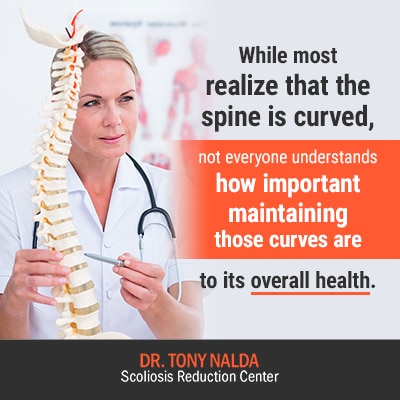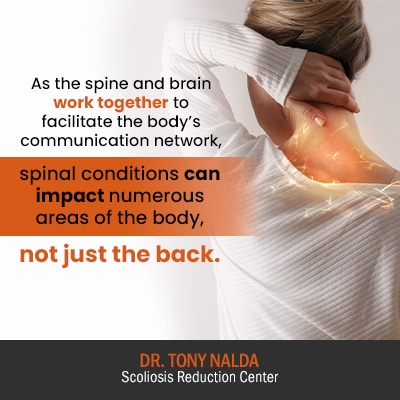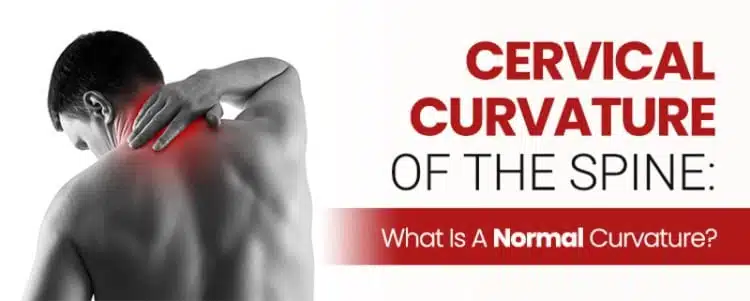The spine has three main sections with three corresponding natural curvatures, when viewed from the side. When one or more of these healthy curves are lost, the body responds by putting in bad curves. Unhealthy curvatures impact the spine’s overall biomechanics and impair its ability to function optimally.
‘Cervical curvature of the spine’ refers to its upper portion, including the neck. While a typical cervical curvature would bend inwards, towards the body’s center in a soft reverse-C shape, an atypical cervical curvature could compromise the integrity of the neck and introduce ‘forward head posture’.
In order to better understand the importance of maintaining the spine’s healthy and natural curvatures, we’ll start by exploring some basic spinal anatomy and the role of the spine’s healthy curvatures.
Basic Spinal Anatomy
If you look at the spine from the side, it has a soft ‘S’ shape; this shape is maintained by the spine’s healthy and natural curvatures.
There are three main sections to the spine: cervical, thoracic, and lumbar. ‘Cervical’ refers to the upper portion and neck. ‘Thoracic’ includes the spine’s middle portion, and ‘lumbar’, the lower back.
Each of these main sections has a corresponding natural and healthy curvature. The spine’s cervical curvature curves inwards, towards the body’s center, in a reverse-C shape. The thoracic spine’s curvature curves outwards, away from the body’s center, in a ‘C’ shape, and the lumbar curvature curves inwards, again, in a reverse-C shape.
The terms ‘lordosis’ and ‘kyphosis’ refer to these different types of curvatures:
- Lordosis: inward curvature of the spine
- Kyphosis: outward curvature of the spine
When the cervical spine loses its healthy lordosis, it can make the neck unnaturally straight.
Role of the Spine’s Healthy Curvatures

While most realize that the spine is curved, not everyone understands how important maintaining those curves are to its overall health.
The spine’s healthy curvatures give it increased strength, flexibility, and facilitate its ability to evenly distribute the mechanical stress that’s incurred during movement; this is important so that no one portion of the spine is bearing excess weight, introducing uneven forces and adverse spinal tension.
The curves work together to function like a coiled spring to better absorb force. They also enable the body to maintain its center of gravity and balance, and the flexibility it gives the spine makes it possible for us to bend and twist.
What Happens When the Spine Loses its Healthy Curvatures?
When the spine loses one of its healthy and natural curvatures, it affects the spine’s overall function by impairing its strength and flexibility and impacting the spine’s other healthy curves.
As mentioned, the body responds to a loss of healthy curves by putting in bad curves. Curvatures from the side are referred to as ‘sagittal’, and curvatures from the front are referred to as ‘coronal’.
When a sagittal curve is lost, the body is going to respond by putting in an opposite curve, so a coronal curve will develop. The tendency of the body to replace lost healthy curvatures with opposite curves can lead to the development of abnormal spinal curvatures: scoliosis.
With scoliosis, there are a lot of uneven forces at work, and these can produce postural changes in the body that impact its overall symmetry.
The Importance of a Healthy Cervical Curvature
Each of the spine’s natural curvatures play a role in how that section of the spine functions and impacts other sections of the spine. It’s crucial to have a healthy cervical curvature because when the neck loses its cervical lordosis (inwards curvature), the neck’s integrity is compromised.
With a loss of cervical lordosis, the neck becomes weaker, less able to support the weight of the head, and can lead to what’s known as ‘forward head posture’ or ‘military neck’.
Forward head posture occurs when the loss of cervical lordosis has made the neck abnormally straight, which posturally shifts the head forward in an effort to better stabilize the neck.
On average, the head weighs around 10 lbs, but with a shift in forward head posture of even an inch, the approximate weight of the head doubles to 20 lbs; a two-inch forward shift would increase the weight of the head to 30 lbs.
The body responds to these uneven forces by twisting and turning unnaturally in an effort to better support the head’s forward-tilt position.
A healthy cervical curvature is essential to preserving the spine’s overall biomechanics because the neck has to support the head. Once that curve is lost, the way the body responds with unnatural twists and turns impacts the thoracic spine by making it straighter too.
With a healthy spinal curvature, the spinal cord passes through the spinal canal. As the spinal cord continues from a normal curvature to an atypically straight neck, the distance of that canal increases by approximately 24 percent. As the spinal cord can normally only stretch by 10 percent, this introduces a lot of adverse traction that irritates the spine.

As the spine and brain work together to facilitate the body’s communication network, spinal conditions can impact numerous areas of the body, not just the back.
Atypical Cervical Curvatures can Impact the Brain
As the brain and spine work together to form the body’s central nervous system (CNS), a loss of cervical lordosis and a straighter neck can also impact the brain and its meninges (membranes that cover and protect the brain and spinal cord).
While the meninges consist of three layers, the one most impacted by an atypical cervical curvature is the dura mater. The dura mater is made up of ligaments that are strong and durable, and these ligaments are naturally diagonal.
As the meninges provide support for cerebral and cranial vasculature and work with cerebrospinal fluid (CSF) to protect the CNS, a condition that impacts the meninges can produce a number of effects throughout the body.
As the neck area becomes straighter, it squeezes the spinal cord and its meninges, introducing up to 30 or 40 lbs of compressive forces. The introduction of this adverse mechanical tension in the cervical spine also makes the body respond with unnatural twisting and turning motions as it tries to decrease this adverse spinal tension, and this can, again, lead to the development of scoliosis.
What is Scoliosis?
As I’ve mentioned that a loss of cervical lordosis and forward head posture can lead to the development of scoliosis, let’s take a look at what that means.
Scoliosis is defined as an abnormal sideways curvature of the spine that includes rotation. Scoliosis is a 3-dimensional condition, meaning the spine doesn’t only bend forwards or backwards, left or right; it bends, curves, and rotates in multiple directions.
Scoliosis can develop at any age, but it most commonly develops in adolescents. In fact, adolescent idiopathic scoliosis diagnosed between the ages of 10 and 18, accounts for 80 percent of known diagnosed scoliosis cases; the other 20 percent are cases with known causes such as congenital, neuromuscular, degenerative, and traumatic.
Scoliosis is an incurable and progressive condition, meaning it’s in its nature to worsen over time. Although scoliosis is incurable, it can most certainly be treated effectively by managing the condition’s progression and working towards impacting the condition on a structural level, in the form of a curvature reduction.
If your range of motion seems decreased and you are experiencing headaches, pain, a loss of muscle strength, and notice your neck looks straighter than it used to, a loss of cervical lordosis and a cervical-scoliosis diagnosis could be forthcoming.
Here at the Scoliosis Reduction Center®, we offer our patients proactive scoliosis treatment delivered through a functional approach that combines multiple scoliosis-specific treatment disciplines: chiropractic care, in-office therapy, custom-prescribed home exercises, and specialized corrective bracing.
Conclusion
The spine allows us to maintain straight and upright posture, balance, engage in flexible movement, and works with the brain to form the body’s central nervous system.
Preserving the spine’s health and function is essential to a person’s overall health, just as preserving the spine’s natural curvatures is essential to the spine’s overall health and function.
The spine’s cervical curvature refers to its upper portion and neck; maintaining this curvature is important because the neck is responsible for supporting the weight of the head.
When a person experiences a loss of cervical lordosis, this can cause forward head posture to develop, making the neck straighter and less able to support the increasing weight of the head.
As the body responds to a loss of normal spinal curvatures by replacing them with opposite curves, this introduces adverse spinal tension and uneven forces, and can lead to the development of scoliosis: a spinal condition characterized by an abnormal sideways curvature of the spine, with rotation.
While an atypical cervical curvature doesn’t automatically result in the development of scoliosis, it does increase the likelihood as it impacts the spine’s overall health and ability to maintain a healthy alignment.
With scoliosis, the forward head posture caused by a loss of cervical lordosis and the uneven forces it introduces causes the body to twist and turn unnaturally to support the head, and this is how the condition develops.
If you have developed an atypical cervical curvature, reach out to us here at the Scoliosis Reduction Center® so we can work towards restoring the neck’s natural lordosis and preserving the spine’s overall health and function.





